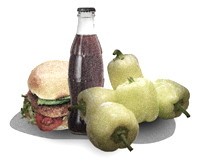A guide to cholesterol alternatives
For the majority of us, fats are not something that we need to consciously include in our diet.
Healthy fats are found naturally in many foods, so oil, butter or margarine are generally unnecessary additions to our cooking, health-wise. But sometimes the taste or the texture of the added fat is required to really pull a meal together. When it comes to choosing which added fats to use for cooking purposes, it helps to consider the health benefits – and drawbacks – to the kinds of added fats that we use.
The butter versus margarine debate has been raging for years, but in the end, both of these can have their advantages, depending on the brand of margarine. Butter is an all-natural, real food, so it is an excellent choice. However, it contains saturated fat, and some kinds of saturated fat have the effect of raising blood cholesterol levels. If you are trying to watch your cholesterol levels, it would be wise to minimize your use of butter and choose another kind of added fat instead.
All oils are cholesterol-free because cholesterol is only found in animal products. This doesn’t necessarily mean that all oils are inherently “better for you” than butter, however, or that all oils are equal. Olive oil is full of heart-healthy monounsaturated fats, but it cannot be heated at a very high temperature. Another healthier oil choice is grape seed oil, which can be heated at high temperatures.
If you need a solid fat rather than a liquid one for baking but are vegan or prefer not to use butter, your alternative is margarine. Be wary of which margarine you choose! Most are made with hydrogenated or partially hydrogenated oil. These types of oils are used because they give margarine a spreadable texture, but both hydrogenated and partially hydrogenated oils are trans fats. Trans fats increase risk of heart disease by raising blood cholesterol levels (and by lowering the good kind of cholesterol levels in the body). Trans fats are both man-made and toxic, so it is best to completely avoid them. If you want the spreadable aspect without the trans fats, let your butter soften at room temperature right before you want to use it.
The best brand of margarine is Earth Balance. It is an all-natural, vegan spread that tastes like butter and uses a variety of healthy vegetable oils. There are very few other brands of margarine that do not use either hydrogenated or partially hydrogenated oil, nor artificial flavouring or colouring.
Whichever kind of added fat you choose, it is always best to consume foods with real (and not man-made) ingredients.
When considering which kind of added fat to use in our cooking, it is important to remember that even the “healthier” options should still be used in moderation. A serving of added fats is no bigger than 1 tsp. A little bit of added fat goes a long way to reach the desired taste and texture that really makes the meal.
University of Winnipeg student Sagan Morrow writes a health and wellness blog. Check it out at www.livingintherealworld.net/healthy
Published in Volume 64, Number 21 of The Uniter (March 4, 2010)







